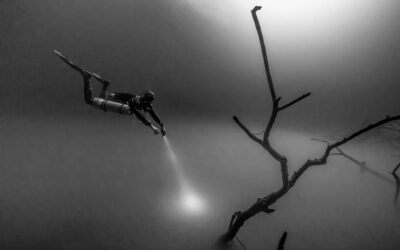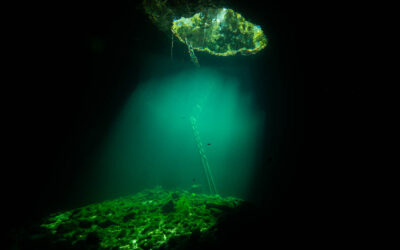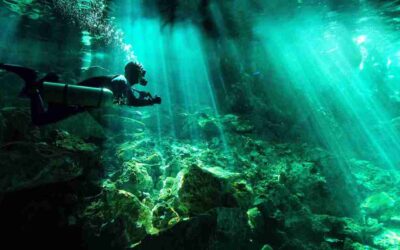What is The Pit Cenote Mexico?
The Pit is a Cenote near Tulum in Mexico. It is primarily used for deep scuba diving.
Where is the Pit Cenote?
The Pit Cenote Mexico is between Tulum and Playa Del Carmen. It is about 20 min drive from Tulum and 40 min drive from Playa. Take the sign on the federal highway for Dos Ojos.
How Deep is The Pit Cenote?
The Pit has been explored to a maximum depth of 119m / 390ft. I don’t dive that deep. The maximum depth for recreational divers is 40m. To dive beyond that depth you will need special permission.
How can I Scuba Dive The Pit Cenote Mexico?
If you have an Advanced Open Water Scuba Certification from a recognized training agency, it will be our pleasure to take you scuba diving in The Pit Cenote Mexico.
When is the Best time to dive The Pit?
The conditions for scuba diving in The Pit cenote Mexico are great all year round. However, the light beam effect is better in the summertime as the sun passes directly overhead. In the winter the sun doesn’t get as high. In the summer it is best to go later. In the winter it is best to go earlier in the day. The best time for the light is the summer solstice but it is often sunnier, less chance of rain and equally good effect slightly earlier in May.
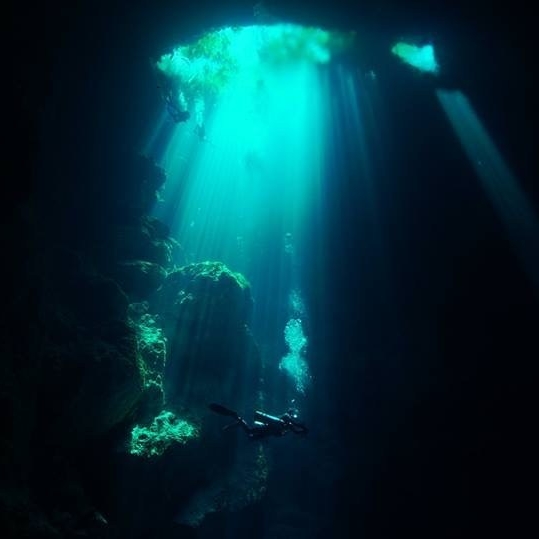
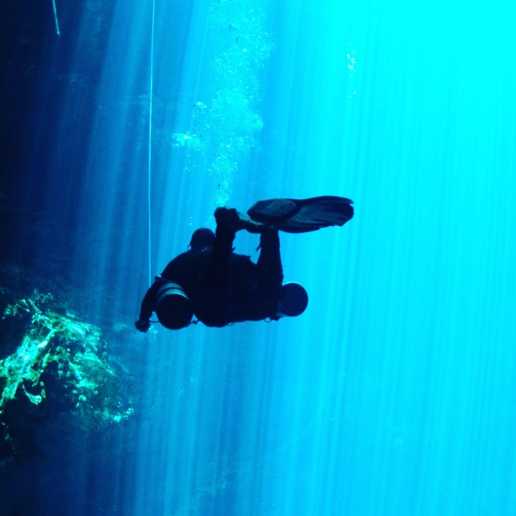
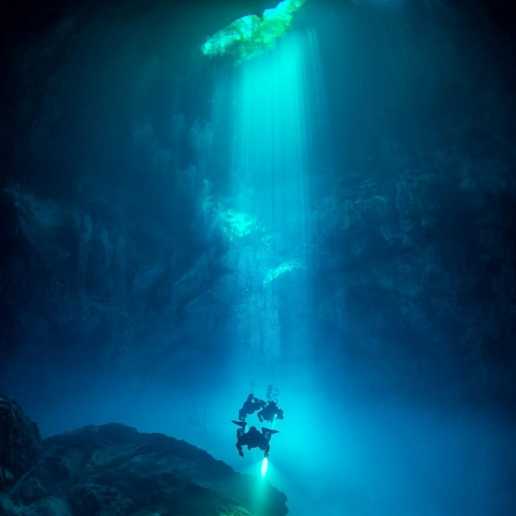
What can I see in The Pit Mexico?
Diving The Pit Mexico we see many beautiful cenote features like light beams, stalactites, halocline, and a hydrogen sulfide cloud.
Are the light beams as awesome as people say?
For me, diving in the pit cenote is the most awesome journey through time and space imaginable in a single experience.
We drive through the jungle where we find a rather normal Cenote entrance with a flight of steps that lead down to a small area of open water.
Diving The Pit Cenote Mexico
In the briefing, the divers start to hear the enthusiasm in my voice and they know something awesome is about to happen. I’m talking about “Laser beams” of light, a massive chamber and dropping down into the deepest Cenote cave in the Yucatan.
We kit up, check and walk down the steps and jump in. After a weight check, we switch on the lights, as we begin our descent, safely in a controlled group. All ok. Down into The Pit Cenote Mexico, we go.
Descent
As we hit the halocline everything goes blurry for a minute, but it’s ok. I know it’s the refraction of the light as I transition from the lighter freshwater above to the heavier saltwater below. The light bends as it passes through the different densities of water. It has a similar effect as a mirage on hot sand or hot tarmac, or when pouring gasoline. The blurriness goes away under the halocline layer.
As we move from the well-lit entrance area we start to appreciate the size and scale of the chamber we are now entering. It is vast, awe-inspiring, even before we start to think, This chamber was eroded slowly over time by water flow eating away at the rock. I am struck by a sense of wonder as I descend lower down surrounded by rocks, that I am going back in time. The rock was laid down as sedimentary deposits, older at the bottom, more recent higher up.
Chamber
But this chamber it’s just so vast that when we enter the darkness we appreciate the size and scale. On the wall we see dirty stains marking the water surface level during the ice age when sea levels were considerably lower than they are today. All of this is evidence of the enormously slow and long process needed to form these cave systems.
Working our way to the back of this chamber we see stalagmite formations on the floor 30m below the surface. Evidence that the water level was once lower than that, further proof that sea levels were once considerably lower than today.
Dancing light
At the back, we pass behind a rock. I’m getting you in position. I’m lining you up to see what I see. I’m about to show you the awesomeness of what lays before you because at the back of that chamber laid out before me, the universe, space and time come into alignment in one perfect picture. Let me explain.
I see light. Light from the sun. Travelling in a straight line, clean and crisp, a perfect wall of light. Then magic. A ripple on the surface. It spreads as waves across the surface. The waves bend the light, concentrating it into intense beams of a stunning light that appear to dance before us as if an orchestra in its grandeur. For me, this demonstrates wave theory. Bending electromagnetic light waves before I provide the best experimental proof of the theory.
Bubbles
Then the bubbles, rising 30m/100ft in this wall of shimmering, dancing, light….expanding as they rise. Seeing the bubbles expanding, not just demonstrating the physics of Boyle and Newton, but all the diving rules we love to follow.
So before me in on beautiful vista I have very real evidence of the extraordinarily long time needed to form the space, evidence of electromagnetic wave theory and evidence of Boyle’s law. This is science at its most beautiful and wonderful.
Coming shallower we see two ledges with plastic tags attached marking the points where significant archaeological finds have been made. Human and animal bones, as well as pottery and other artefacts, have provided archaeologists with a unique understanding of life on the Yucatan peninsula thousands and maybe millions of years ago.
Multi-level
Down deep
Then we drop further into the deepest Cenote cave in the Yucatan, but not too deep, this thing goes down to 119m so we’re not going that deep today. Looking up at the entrance we still see the stunning light show illuminating up to the entrance.
Hydrogen sulfide cloud
As we swim back towards the entrance we see the cloud of hydrogen sulfide gas appearing like a layer of smoke in the water, caused by the decomposition of organic matter at depth, under pressure. When the light hits it around you the experience is surreal, as if passing through a warp gate.
Above the cloud, we are regrouping, checking gas and working shallower. Let’s go back up to the halocline level. Coming up from salt to fresh water is unusual the first time. You become heavier. As you come from heavier salt to lighter freshwater, you seem to gain weight. So, counter to everything you have been told in diving before, you need to add air to your BCD as you rise to become neutrally buoyant in the freshwater above. And we do want to float above because below is the halocline.
Halocline
A wonder in light dynamics that I’ve only experienced in cenotes. Light refracts, it bends, making the layer visible. We can see the water flowing, the light bending and the rocks bending. But only if the layer is nice and calm and flat. If we kick it up it goes back to that blurry mess.
Stalactites & stalagmites
At the back of the chamber, two cave entrances are home to some beautiful Stalagtites and stalagmite formations. On the ceiling pockets of collected air from our previous lower circuit of the chamber, have gathered on the ceiling above us. Appearing like mercury, the shimmering light effects are super cool when we bounce our lights off of them.
Archaeology
A nice multi-level profile brings us ever close to the surface, the open water area and those dancing laser light beams. Holding a safety stop can be challenging as we hover in the dancing light. The temptation to dump my gas and go back down again is ever-present. But I’ve got to look after you guys. So we come up.
What is the Best Dive in Mexico?
The Pit Cenote Mexico in Tulum is the best dive.
I’ve worked in diving all over the world and I’ve learned that you can’t guarantee Dives. Well, here I can. The conditions are awesome. If we time it right, avoid the crowds and get in with fewer other divers, I put this as one of the most awesome, epic extraordinary and completely different diving experiences possible for recreationally trained divers anywhere in the World.
Everyone says how awesome it is, everyone is super happy and sometimes people are touched by the same magic I experience every time I go to this amazing and special place.
The Pit Cenote Diving Mexico
You see most of the time people come Cenote diving because they have been told it’s awesome. They don’t quite know why, yet, but the guy that told them to do it was really convincing. You see we are going to see rocks and light. Before they do it no one is fully convinced that rocks and light can be as beautiful as fish and coral. All their diving before was about fish and coral. If it’s a relative newbie, a seasoned diver or an instructor, all their dives before have been about fish and coral.
Now there’s a guy here, telling me we’re going to drive through the jungle, no boat, get into a hole in the ground, there’s going to be no fish no coral, just these rocks and light he keeps going on about. And he’s trying to convince me that this is going to be one of the best dives I’ve ever done. It’s is as if I am being challenged. “Go on, show me this awesome dive then.”
Love Diving The Pit Cenote Mexico
Everyone loves it, everyone finds it amazing. I see it in your smiles and your eyes, you are super happy. So let me take you on this most epic diving experience. Come and see what I see.
The Pit Diving Tours
Angelita Cenote Mexico 2021 Hydrogen Sulfide Cloud Underwater
Diving in a cloud of Hydrogen Sulfide Underwater at Angelita Cenote Mexico
Cenote Calavera Tulum is the Temple of Doom Mexico 2021
Have you seen the Halocline Scuba Diving Cenote Calavera, Tulum?
Dos Ojos Cenote Diving 2021 Largest in the World
Discover the Largest underwater cave system in the World, Scuba Diving Dos Ojos Cenote
